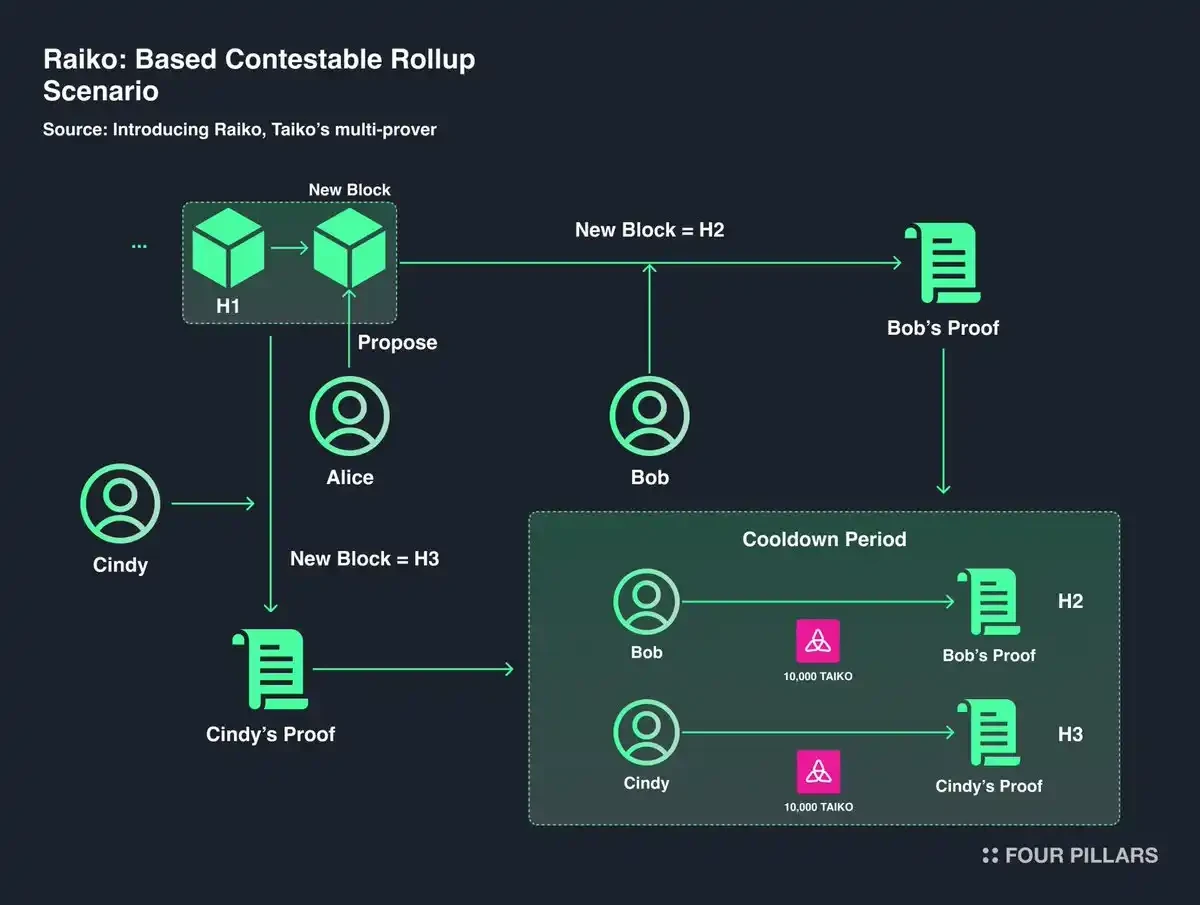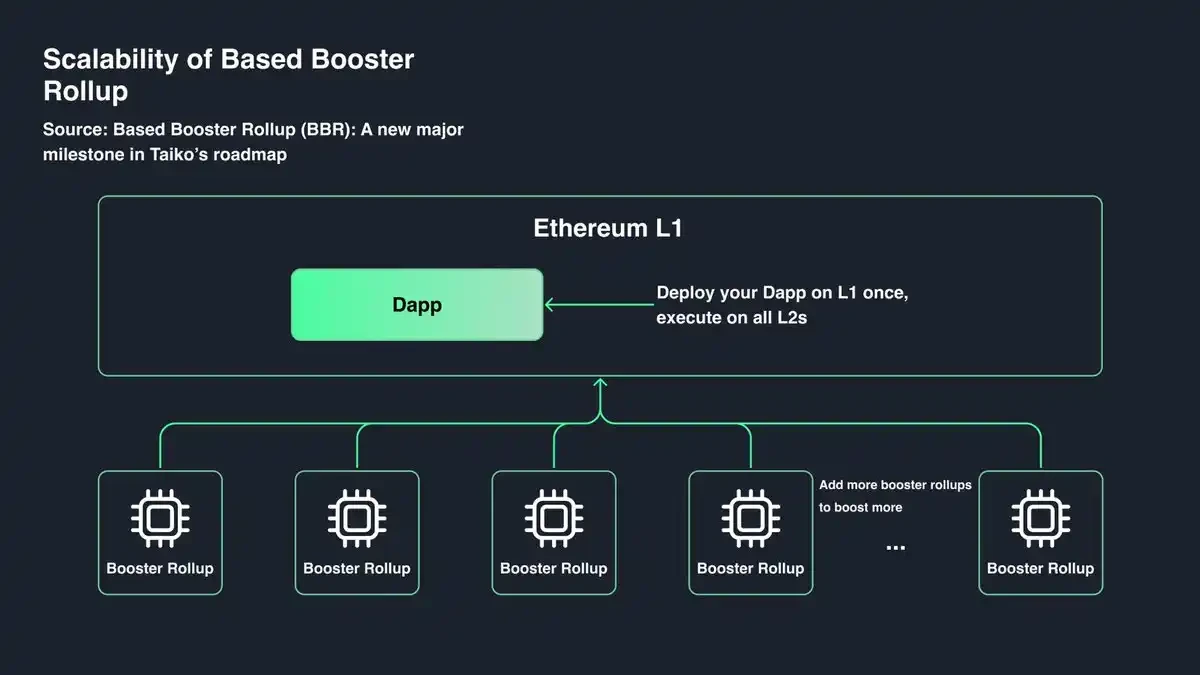Bagaimana Taiko memimpin jalan menuju desentralisasi Rollup?
Original article by @xparadigms and @IngsParty
Original title: Decentralizing Rollups: A Neglected Priority in Rollups
Original translation: weizhi, BlockBeats
Decentralization is one of the core values of blockchain. However, in order to improve the scalability of Ethereum, the Rollup solution sacrifices some decentralization in operation. Achieving full decentralization of these operations still faces challenges in ordering and proof of settlement, especially for optimistic Rollup and zero-knowledge (zk) Rollup.
Despite these challenges, the development of decentralized Rollups is accelerating. Some optimistic Rollups have introduced permissionless challenge mechanisms and are testing hybrid proof systems. The Taiko project stands out for its clear decentralization roadmap. Let’s take a deeper look at why.
1. Background – Core Components: BCR and BBR
Taikos Road to Decentralized Rollup introduces two proof systems and frameworks: Contestable Rollup (BCR) and Booster-based Rollup (BBR).
1.1 Based on Competitive Rollup (BCR) – Powerful L2 Proof System
BCR is a Rollup design that includes a competition mechanism. The design verifies transactions by allowing participants to challenge the validity of transactions when they suspect fraud. This mechanism enhances decentralization because it allows Ethereum validators to use a challenge mechanism to sort transactions without a central sorter, thereby maintaining the integrity of the blockchain.
The BCR mechanism combines the advantages and challenges of Ethereum transaction sorting, aiming to reduce transaction fees while maintaining security and decentralization. In addition, Taiko uses a variety of proof systems in BCR, including SGX, ZK, SGX+ZK and other Rollup proof systems at different stages, ensuring the flexibility of the system and more stable operation.
Despite these advantages of BCR, there is a potential disadvantage in its design: when competition is low, there may be a lack of activity among provers. The structure of provers requires a lot of competition to generate profits, so in an environment with less competition, they may be more inclined not to participate. To address this problem, Taiko implemented dynamic adjustments to different Rollup proof systems to solve this problem.

1.2 Booster-Based Rollup (BBR)
BBR aims to scale Ethereum DApps without redeploying on all L2 solutions. It reduces developer workload and reduces redeployment costs by sharding transaction execution and storage. This design aims to solve the problem of liquidity fragmentation between L2s and enhance the scalability of the network.
In November 2023, Taiko launched a booster Rollup called Gwyneth to enhance Ethereums capabilities. Gwyneth uses Ethereum L1 validators for transaction ordering and L1 builders for block construction. Its main features include synchronous composability for seamless L1 integration, scalability to meet growing demand, and pre-confirmation capabilities for fast transactions.

Gwyneth is finalized from the beginning, and its security is guaranteed by Taikos multi-proof system Raiko, and uses a trusted execution environment (TEE), with plans to introduce zkVM in the future. Both BCR and BBR are part of Taikos efficient expansion solution for Ethereum, ensuring that high transaction volumes can be handled while maintaining security and decentralization.
2. Main points
2.1 “Have we considered decentralization in Rollup?”
FourPillars researcher Heechang believes that at present, most Rollups are still centralized. Decentralized sorting and proof systems are still in progress. Two well-known proof systems, optimistic Rollup and zero-knowledge Rollup, are moving towards decentralization.
Optimistic Proof Systems: These systems have implemented mandatory L1 transactions and are exploring shared ordering and the introduction of permissionless challengers. Arbitrum and Optimism allow permissionless challenges, but Optimism recently banned this mechanism due to a suspected vulnerability.
Zero-knowledge proof system: Most zero-knowledge Rollups do not allow forced transactions in L1. Although zero-knowledge proofs provide secure state change guarantees, operations are currently still centralized and technical challenges remain significant.
Although not fully decentralized at present, Rollup frameworks like OP-Stack, ZK-Stack, PolygonzkEVM, and ArbitrumOrbit have been adopted by hundreds of L2 projects. This trend is continuing, and Rollup framework teams are working hard to achieve decentralization. However, not all projects have a clear roadmap to meet the challenges of decentralization.
Taiko excels in this regard. From its inception, it has had a clear roadmap to become an L2 and decentralized Rollup framework. It has a clear path forward and working token economics that provide sustainable utility for its L2 token, which is lacking in most other projects.
As other projects are also improving their codebases and infrastructure, will Taiko be able to successfully realize its vision at the right market time? This remains to be verified by time. As one of the teams working closely with the Ethereum Foundation, Taiko needs to pay special attention to its progress in decentralization.
2.2 Its time to consider the decentralization of Rollup
FourPillars researcher Ingeun Kim believes that currently, major Rollup projects are working hard to achieve decentralization. However, no project has made significant progress in achieving full decentralization. The main reason is that todays mainstream Rollups give low priority to decentralization in the initial design stage. These Rollups initially focused on performance and functionality, and now find it extremely difficult to incorporate the concept of decentralization into their rigorous design. This is understandable because in the early stages, Rollup needs to deliver efficient performance results while meeting Ethereums scalability requirements.
However, the concept of Rollup decentralization is becoming more and more important now. Its like the natural transition from the performance-driven Web2 era to the decentralized Web3 era. Fortunately, many Rollup projects have laid the foundation and paved the way for future decentralization. In this context, Taikos attempt at decentralized Rollup deserves active attention. In particular, its design based on the contestable Rollup (BCR) mechanism contains the basic elements for achieving full decentralization, including allowing anyone to participate, as well as fair rewards and penalties.
Of course, there are still many areas for improvement, and the path to full decentralization is challenging. However, Taikos efforts are considered to be of high importance and could have a positive impact on the entire Ethereum L2 ecosystem. Their progress is definitely worth keeping an eye on.
3. Other Views
3.1 The choice is not only a technical issue, but also about decentralization
Taiko member Junger said that with the popularity of Rollup, fragmentation and isolation have become key issues. There is a trade-off in the choice between Rollup-based and shared sorting layers. Shared sorters provide fast finality and cross-chain composability, but introduce new trust assumptions and potential failure points. Rollup-based leverages Ethereums infrastructure, provides liquidity and L1 composability, but faces challenges in block time and revenue.
Future improvements may include pre-confirmation based and faster L1 block times to improve user experience while maintaining alignment with Ethereum. The goal is to build a decentralized ecosystem that is scalable and truly in line with the Ethereum vision.
Junger emphasized that choosing whether to develop based on Rollup is not just a technical decision, but about the direction of the decentralized Rollup framework.
3.2 The final outcome is based on Rollup
Justin Drake, a researcher at the Ethereum Foundation, has been actively involved in discussions about Ethereum scaling solutions, especially focusing on Rollup and Taiko projects. Drake emphasized the importance of decentralized ordering, which can alleviate monopoly control and censorship issues in transaction ordering. He believes that integrating technologies such as zero-knowledge proofs and shared orderers can enhance the functionality and security of Rollup-based.
Justin Drake believes that Taiko is an important step towards a decentralized and scalable Ethereum ecosystem, and that its mainnet’s permissionless ordering and proof system is a notable feature. He also said that “the end game will be based on Rollup.”
Related articles:
– Booster Rollup (BBR): A new milestone in Taiko’s development—Taiko Labs
-Centralization Considerations for Pre-Confirmed Rollups (Part 1) —Taiko Labs
-Multiple Proofs | Taiko Documentation
This article is sourced from the internet: How does Taiko lead the way to decentralization of Rollup?
Related: A look at 15 recent crypto projects that have been driven by catalysts
Original author: Ignas | DeFi Original translation: TechFlow The current crypto bull run is primarily driven by external macro factors, but exciting new product launches and catalysts are coming that will drive the internal crypto ecosystem forward. Here are the top 15 projects I’m keeping an eye on: Monad (expected to be launched on the mainnet by the end of 2024) Do we really need another alit-L1? Will it become another sell-off with low circulation and high market valuation? Can Monad attract unique, non-forking decentralized applications (dApps)? MegaETH (expected to be launched on the mainnet by the end of 2024) Is it an ordinary second-layer solution, or a real game changer that brings heat to the ETH+L2 modular expansion roadmap? Can it truly achieve 100,000 transactions per second (TPS) and…







